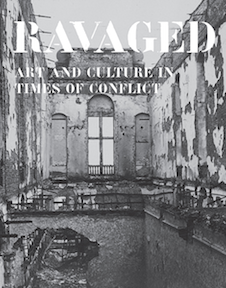By Lewis Fried
Ravaged is based on the exhibition of the same name, held at the M-Museum Leuven, in 2014. Given its title, this book is, ironically, handsome, in fact, lush with photographs and reproductions of paintings, posters, sketches, and prints. Through these, as well as numerous short essays, the editors present a selected history of art in times of war, from the sixteenth century onwards, ending “where allegory became propaganda.”
Ravaged is a chosen history of the ideas and representations of iconoclasms. We have before us its many forms, from the smashing of monuments to the burning of books, from the sacking of artworks to the call to burn tradition. Its aim, Jo Tollebeek explains, is not to be exhaustive but to show how “iconoclasm has multiplied.” This book appears at a crucial time in our history: we watch insurgents, rebels, fanatics, lunatics, and thugs slaughtering anyone in their path, and destroying art. Rightly so, this book must address politics and culture, and it does. I want to turn to but a few essays in this book, each piece functioning as part of a mosaic.
Forefront is Ravaged’s address of the warfare between Mars and Minerva. Most of the essays—and they are all invaluable—spring from this contest. Koenraad Brosen’s “Mars and Minerva Have Never Been the Best of Friends” deals with the implications of this struggle. Artists, many of them, understood that “Mars” had to find a place in their “vocabulary,” attaining a “place in their visual strategies.” As the other essays point out, this also became a remarkable union: Mars is partly domesticated by the powers of wisdom.
Eradicating, or turning into rubble, monuments that convey the signal moments of civilization is one way of dealing with the conquered. Such devastation, of course, does not destroy a society’s world-view any more than blowing up a stove destroys cooking. However, it is a remarkable and brutal acknowledgment of the fragility of arts and letters whether in the service of democracies or dictatorships. Tom Verschaffel’s “Book-Burning” addresses the obliteration of communal memory through “libricide.”
The artwork of the conquered is an unusual object. Creation and reception are challenged. How do we look at the arts of National Socialism? Or of the proletarian monoculture of Soviet “realism”? Can we look at a painting stolen from its owners without placing it in the context of spoliation. Yet traditions defining art are rarely unchallenged, are often changing, and crowd out competing, lingering pasts that revivify at surprising moments. Iconoclasm is a tradition in itself. And, as the editors argue, we should say “iconoclasms.”
Can the resources of art, in fact the aesthetic imagination striving to interpret and make a whole out of experience, be seen as unimportant, or a noble attempt exalting a culture in the light of suffering? Or, a small redemption? Does art, in fact, accede to the attractions of brutality in its portraiture? In Steven Jacobs’ provocative “The Sublime Ruin of the City,” Burke’s analysis of the sublime stressing “privation, vastness, and infinity” is applied to the bombed cities that were well known to every European coming of age in the 1940s. Yukie Kamiya’s “Imaging Hiroshima” explores how memories of Hiroshima and the regeneration of that city presented artists with a challenge: can “conceptual means” rather than “specific identifiers” rescue Hiroshima from “oblivion”?
Cities, destroyed, rebuilt, or luckily undamaged can be grasped through a variety of instruments: graphs, maps, literature, oral traditions, emotional associations, and so on. Never static, they are almost impossible to capture by any means. Or even all of them. Think of Leopold Bloom and Stephen Dedalus’ journeys across Dublin. Or, for that matter, the diagrams of real and imagined cities that urban thinkers used and still use to present the ruined and the regenerated metropolis. But the arts themselves often excoriate what has come before, breaking the icons constituting a tradition. Marinetti’s manifesto on Futurism, well-presented by Johan de Smet’s “The Revolt of Futurism,” demanded that a war was needed to purge, if not destroy, cultural institutions: “Heap up the fire to the shelves of the libraries !”
Responsively, restoration and conservation were—and are—resurgent acts. They re-establish and re-present cultural memory in the face of ruination. As Linda van Santvoort’s “Nineteenth-Century Restoration Mania” points out, an idealized building, one that was “perfected and embellished,” harmonized “tradition and modernity.” Sentiment for or against indicated the large background: should permanence or process dominate urban planning and rebuilding? Sigrid van der Auwera and Koenraad van Balen’s “The Hague Convention, 1954,” studies the evolution of a consensus: cultural “property” demands protection.
A fitting end is Peter Weibel’s “The Accelerated Circulation of Images”; the title reminding us of both Walter Benjamin’s and Lewis Mumford’s meditations about mass production not only of art but also as a shaper of the imagination. Images, Weibel contends, are often put in the service of the modern state, both as a form of social control but also as promoters of the idea of the permanent war. Modern media suffuses our lives with conflict: if war is not happening here, it is happening somewhere else. So many of these images, Weibel observes, are meant to resemble, or reinforce each other.
Is there any way out? Perhaps not. Nevertheless, among the last plates in the book are those of “L’Ange au Sourire”: photographs before and after the war of the statue of an angel, once whole, later ruined, whose unusual visage offers no answer to the struggles of Mars and Minerva, but only a haunting, curious amusement.
Lewis Fried (ΦBK, Queen’s College, CUNY, 1964) is Professor of English Emeritus at Kent State University and a resident member of the Nu of Ohio chapter of Phi Beta Kappa.




